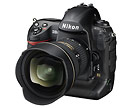Nikon D3S HD Video
 The D3S is the first FX-format (full frame) camera from Nikon to offer the D-Movie video mode. Like previous video-enabled Nikon DSLRs, the D-Movie mode captures 1280 x 720 resolution (720p) video at 24 frames per second. It has a stereo microphone line-in and a built-in mono microphone. The motion JPEG video format has been refined to reduce the jelly-like rolling shutter effect that was noted in some Nikon D90 video clips.
The D3S is the first FX-format (full frame) camera from Nikon to offer the D-Movie video mode. Like previous video-enabled Nikon DSLRs, the D-Movie mode captures 1280 x 720 resolution (720p) video at 24 frames per second. It has a stereo microphone line-in and a built-in mono microphone. The motion JPEG video format has been refined to reduce the jelly-like rolling shutter effect that was noted in some Nikon D90 video clips.
The Nikon D3S is the first digital SLR that can use the auto focus system in the movie mode. It doesn’t have full continuous auto focus like the Panasonic and Olympus Micro Four Thirds cameras. But the Live View contrast-detect auto focus can be used to touch up focus while filming. With all other digital SLRs that have video modes you have to focus manually while recording video – or stop recording to refocus. The D3S also takes advantage of the camera’s high sensitivity with a High Sensitivity Movie Mode that makes filming in almost total darkness possible. Aperture priority mode allows creative aperture control for selective depth-of-field.
I’m not sure why Nikon has yet to increase their video resolution to full HD 1920 x 1080 pixels (1080p). Especially considering that Canon now has two high-end DSLRs with 1080p video resolution. The D3s press release says – and this is a good argument – that the 720p resolution means smaller, faster video files that are easier to transfer, store and edit. And the reality is, most video will likely end up on YouTube where 720p is more than adequate. But the D3s is built to be a professional camera body. If you’re a multimedia pro who wants the best video quality, the lower video resolution could be an issue. On the other hand, the overall performance of the D3s – still image quality, speed and video, is currently unmatched. Until Canon fires back…
Other Nikon D3S Features
There’s a lot to the Nikon D3S besides improved high ISO performance, lower noise and the D-Movie mode. Since the camera was designed for photojournalists, sports photographers and outdoor photographers who subject their gear to all kinds of weather and abuse, the D3S is built to withstand dust, moisture and shock. The buffer size has been increased and the XPEED processing has also been updated. Obvious benefits are a fast frame rate (9 frames per second full-resolution NEF RAW), lower noise, and 12 or 14-bit image files. A surprise bonus – the new XPEED processing also uses less power. That makes it possible for the D3S to capture an incredible 4300 shots per battery charge.
It wouldn’t be a pro camera body without a worthy auto focus system. The D3S has 51 AF points with 15 cross-type sensors and 36 horizontal sensors. The AF points can be selected individually or in Dynamic-Area AF or Auto-area AF modes. Nikon’s RGB metering sensor and Scene Recognition System can track a subject across the auto focus sensor array as well meter and control white balance.
Last but not least – Nikon’s new pro body has a sensor dust removal system. Because sensor cleaning is standard with digital SLRs now it would seem to be an obvious feature to include. But the original D3 missed the boat with sensor cleaning and the 24.5-megapixel D3x doesn’t have a dust removal system, either. So photographers are right be concerned. No sensor-cleaning was one of the main complaints photographers had about the top end Nikon digital SLRs. But not anymore. Nikon can cross sensor cleaning off the list with the D3S.
next page – Nikon D3S Conclusion & Photos >>



That 6400 shot is awesome. I see about the same noise in my 3200 shots (D700). I would love to play with some video, but I wonder what the max record time is ….5 minutes?
I can’t remeber any numbers off the top of my head and I couldn’t find a limit listed in the D3S specs. But other VSLR video clip limits are in the neightborhood of 5 minutes. That may seem short. But unless you’ve got your camera set up on a tripod to shoot a dance recital, it’s not really a big problem. Most video clips end up being a lot shorter than you’d expect. I haven’t shot a ton of video. But in all the box opening and other videos I have done, I’ve yet to hit the clip time limit with a digital SLR.
Yyou should be using the logarithm of the iso when comparing sensitivity with human sensitivity, I have thereforer have doubts that 100K iso corresponds to a pitch black room.
This sounds overly enthusiastic to me.
Enthusiastic hyperbole, definitely. I am curious to find out what the actual low light measures it can capture in will be. It’s three times the previous limit of 12,800, though. And I know people were already describing that ISO setting as able to take pictures in a dark room. But yeah, if we have to be scientific about it, it may not work in a pitch black room. But maybe it will…
Thanks for your comment
This camera is awesome. It looks weird thought and costs alot too.
For a pro-level digital SLR the price is high, but not out of line. As for looks, well, it pretty much looks like a profession DSLR.
I was looking for more pixels too.. but I enjoy the low noise tremendously .. One feature I would welcome from nikon is the ablility to turn off the shutter .. The clicking drives me crazy.. In theater situations/Opera
But Hubert, if you turn off the shutter, you have no shutter. The D3S does have a new quiet mode. Not sure how quiet. But I think they’re addressing your needs
When is the D700 has taken VDO once.
Like D700x or D700s or D700 Upgraded Firmware ?
There are lots of rumors about an upgraded Nikon D700. I don’t know anything about it. But I’m curious to see what kind of specs they’ll give it to position it so it’s a real upgrade but one that doesn’t compete with the D3S. We’ll have to wait and see, though. That introduction will probably happen in March of 2010.
Oh, I want one. Gimme, gimme, gimme! I love the D700 and have been waiting for the new D3 for a while now. I would have liked the same ISO range with a 15 megapixel sensor though. Granted, most of my work is re-sampled down to 6 mega-pixel for printing anyway.
I love the D700 and have been waiting for the new D3 for a while now. I would have liked the same ISO range with a 15 megapixel sensor though. Granted, most of my work is re-sampled down to 6 mega-pixel for printing anyway.
I use the Nikon D2X. Only issue I ever had was the ISO noise. I have compared the D3 images and I was impressed with the low noise. I did a few tests at 3200 ISO on the D3 and I was partially impressed. I would say it was about 2.5 stops better than the D2X in the noise department…. for example the noise I see at ISO 400 on the D2X equals what I saw on the D3 right below the ISO3200 mark. Now when I saw the Images from the D3S… quality and noise wise… I said to my self “I am sold on this one! I think I will upgrade to the D3S. I am impressed.
Cheers